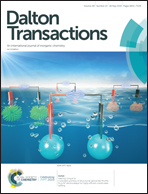Experimental and computational studies on a three-membered diphosphido thorium metallaheterocycle [η5-1,3-(Me3C)2C5H3]2Th[η2-P2(2,4,6-iPr3C6H2)2]†
Abstract
A three-membered thorium metallaheterocycle [η5-1,3-(Me3C)2C5H3]2Th[η2-P2(2,4,6-iPr3C6H2)2] (4) is readily prepared besides H2 from [η5-1,3-(Me3C)2C5H3]2Th(PH-2,4,6-iPr3C6H2)2 (3) upon heating in toluene solution. Density functional theory (DFT) studies were performed to elucidate the 5f orbital contribution to the bonding within Th-(η2-P-P) revealing more covalent bonds between the [η5-1,3-(Me3C)2C5H3]2Th2+ and [η2-P2(2,4,6-iPr3C6H2)2]2− fragments than those in the related thorium metallacyclopropene. Consequently, distinctively different reactivity patterns emerge, e.g., while 4 reacts with pyridine derivatives such as 4-dimethyaminopyridnie (DMAP) and forms the DMAP adduct [η5-1,3-(Me3C)2C5H3]2Th[η2-P2(2,4,6-iPr3C6H2)2](DMAP) (5), it may also act as a [η5-1,3-(Me3C)2C5H3]2Th(II) synthon when reacted with bipy, Ph2S2 or Ph2Se2. Nevertheless, no reaction of complex 4 with alkynes is observed, but it reacts as a nucleophile towards nitriles and aldehydes resulting in five- or seven-membered metallaheterocycles, respectively. DFT computations provide some additional insights into the experimental observations.
![Graphical abstract: Experimental and computational studies on a three-membered diphosphido thorium metallaheterocycle [η5-1,3-(Me3C)2C5H3]2Th[η2-P2(2,4,6-iPr3C6H2)2]](/en/Image/Get?imageInfo.ImageType=GA&imageInfo.ImageIdentifier.ManuscriptID=C9DT01160A&imageInfo.ImageIdentifier.Year=2019)


 Please wait while we load your content...
Please wait while we load your content...